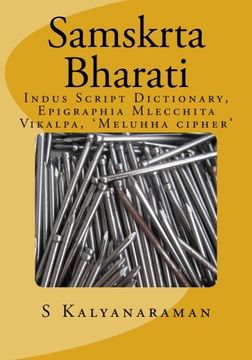Samskrta Bharati: Indus Script Dictionary, Epigraphia Mlecchita Vikalpa, 'Meluhha cipher' (en Inglés)
Reseña del libro "Samskrta Bharati: Indus Script Dictionary, Epigraphia Mlecchita Vikalpa, 'Meluhha cipher' (en Inglés)"
Provides the method for making of Indus Script Dictionary matching hieroglyphs and meanings, traces the continuum of the writing system on artifacts of historical periods in the framework of Samskrta Bharati, language of a civilization of Bharatam Janam. Sanchi, Bharhut torana Indus Script hieroglyphs proclaim mint, metal engraving work. Bharati is the language of Bharatam Janam, an expression used in Rigveda by Rishi Visvamitra signifying metalcaster people. Samskrta Bharati was the language which unified Prakrtam of Bharatiya sprachbund (language union), which had many phonetic variants in an extensive area from Assam to Gujarat, from Kashmir to Sri Lanka. This is treasure, nidhi, heritage of Bharatam. Samskrtam is a structured reconstitution of the semantics, syntax, morphology and phonetics of Prakrtam. This reconstruction is documented in ancient texts such as Yaska's Niruktam, Bhartrhari's Vakyapadiya, Panini's Ashtadhyayi, Tolkappiyam, Patanjali's Mahabhashya, Bharata's Natya Sastra, various Nighantus, Hemacandra's Desinamamala, and scores of other literary evidences. These basic texts have provided the resources for scholarly studies defining Bharatam as a Linguistic Area (Indian sprachbund or language union). Ancient scripts were called Brahmi, Kharoshthi attesting the divine dispensation of Vagdevi and speech forms from the lips of artisans (khar 'smith' oshti 'lip') This discovery of the language of a civilization provides a foundation for further civilization studies including a re-assessment of general semantics, the formation and evolution of all Bharatiya language forms and cultural contacts with neighbouring cultural regions of Eurasia for nearly 8 millennia. The word Samskriti relatable to Samskrtam is the weltanschauung defining both the material resources and adhyatmika foundations for the mores of people of a vibrant region of the globe with a civilizational foundation which dates back to over 8 millennia. Bharata's Natya Sastra (c. 200 BCE), a treatise on performing arts, theatre, dance and music provides a documentation of provincial or des'I or vernacular forms of speech which may be variant pronunciation of sememes (root words of dhAtupATha). This work in 6000 karikas or verse stanzas incorporates 36 chapters three of which relate to messaging systems: Rules of Prosody and Rules on the use of languages, Modes of address and intonation. This work had united Bharatam Janam, the way Prakrtam (spoken version of Samskrta Bharati) had united Bharatam Janam in a Bharatiya sprachbund (language union). DhAtupAtha was the earliest attempt to clearly identify sememes (root morphemes, the smallest linguistic units of meaning) from among multifarious forms of pronounced words in speech forms of Prakrtam. Similarly, Indus Script was the earliest attempt to signify sememes through orthographic signifiers as hieroglyph components in a writing system for parole, speech form of language. Thus, for example, a sememe, kuTi is signified by a water-carrier hieroglyph; a sememe baTa Bhartrhari (c. 5th century CE) Vakyapadiya in Bharatiya grammatical tradition explains the theories on the word and on the sentence and elaborates on sphota, 'spurt, bursting, opening' as a framework to explain how the mind orders linguistic units into meaningful utterances. Indus Script as a writing system is a method in semiotics, a study of meaning-making together with a study of orthography. It is reasonable to hypothesise that Samskrtam in Prakrtam speech forms was the lingua franca of the civilization ca. 2500 BCE on the banks of Vedic River Sarasvati which is consistent with the assumption that Prkritam form of vAk evolved in the region from ca. 8th millennium BCE given the archaeological discoveries of cultural pointers. One pointer is the use of s'ankha turbinella pyrum bangles from ca. 6500 BCe. Another is the practice of sindhur on mang (parting of the hair) of married women on two terracotta toys.

